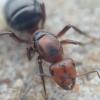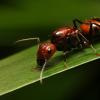Date of collection: late July
Habitat of collection: oak/pine forest
Length: 3-4mm
I caught her at a sandy beach on the edge of a freshwater lake (in between two large formica colonies, if that helps). I saw her as a small black dot struggling to climb a pile of sand. At first I ignored her, thinking she was some random bug, but then i noticed the shimmer of the wings. As soon as I collected her, even before I put her in a proper test tube setup, she began to break off her wings. Also, if this is useful, she has an excellent grip on smooth surfaces.
Sorry about the photos being external links. I tried to add them the way I normally do, but it wouldn't work this time.
https://lh3.google.c...w2560-h1406-iv1
https://lh3.google.c...w2560-h1406-iv1
I apologize for the bad photo quality, as I am not good a photography.




















